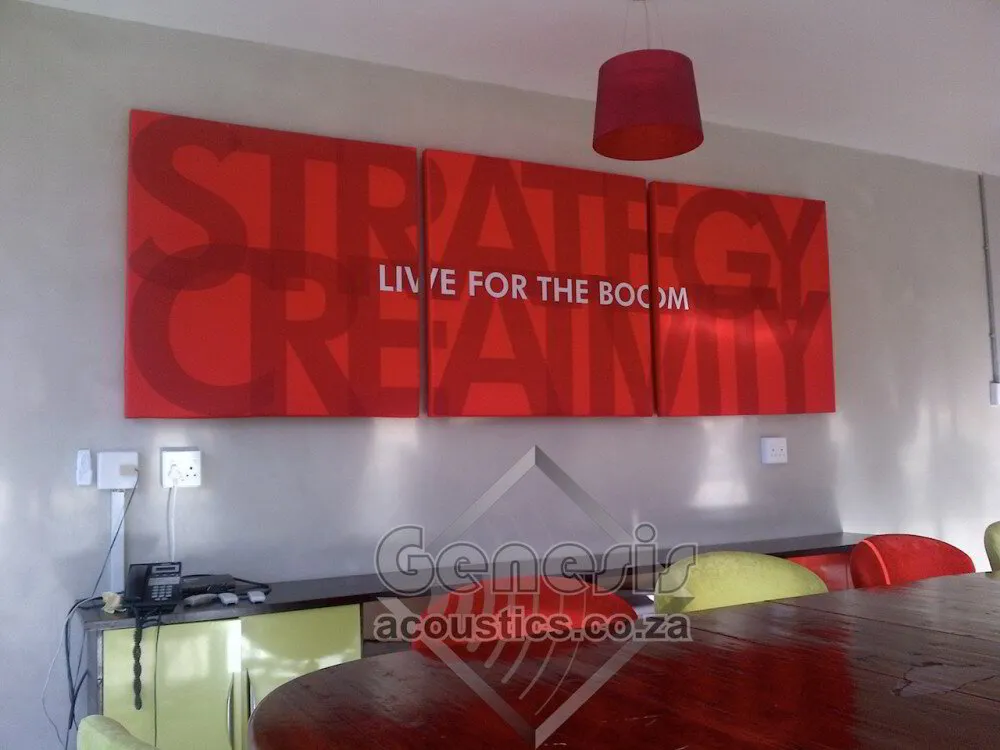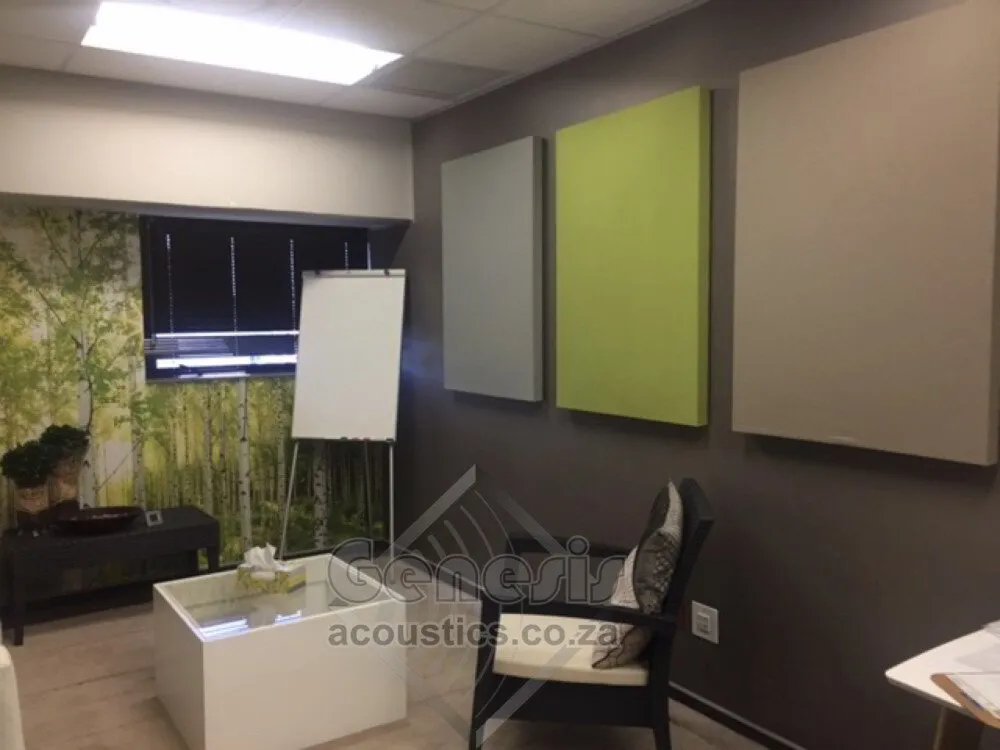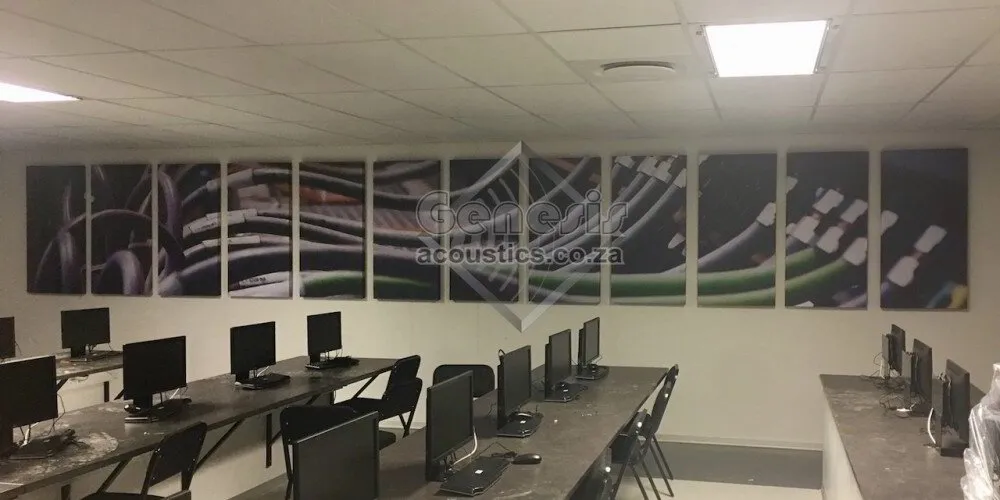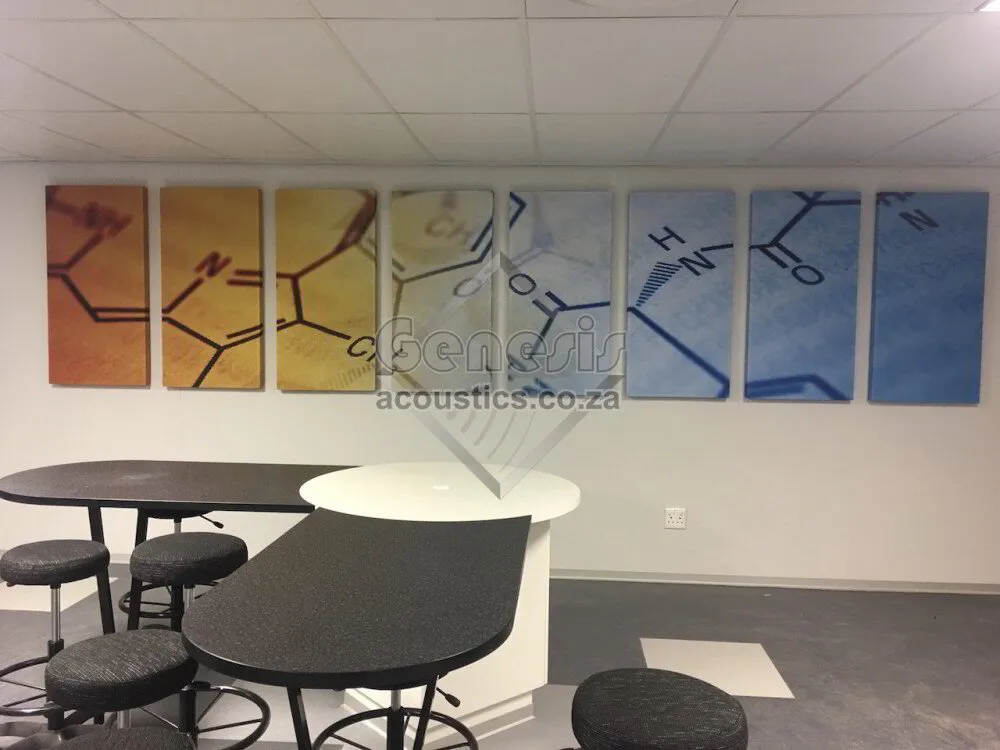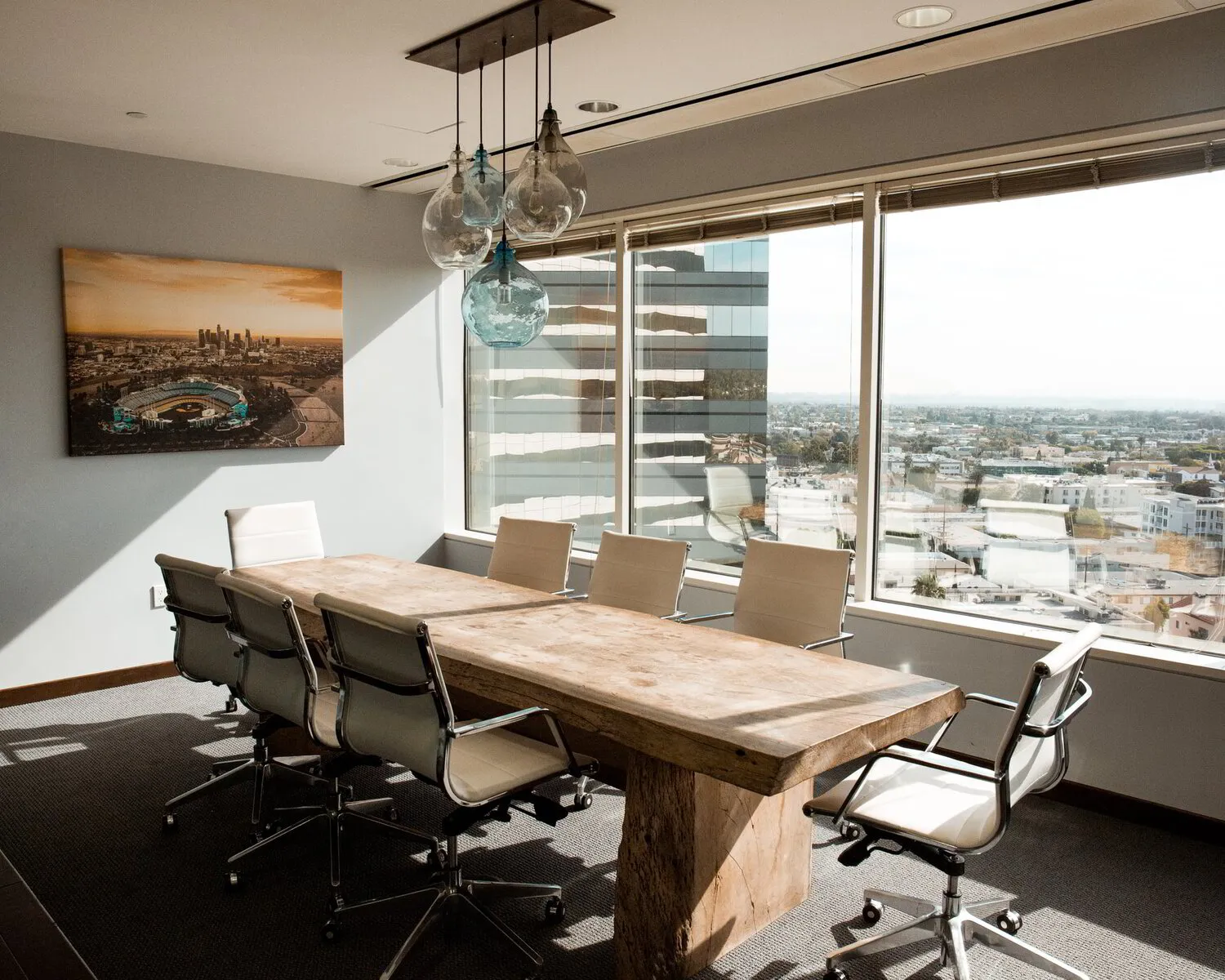Achieving Acoustic Comfort:
A Guide to Soundproofing Boardrooms
Table of Contents
Introduction
10. Conclusion
11. People Also Ask
Introduction
Meeting rooms such as boardrooms, conference rooms, video conference rooms, training rooms and offices are places where business strategies are planned, ideas are discussed and decisions are made. However, all of this can be hindered by problematic acoustics in the room. Meetings can get disrupted by unwanted noise and resonance, which negatively affect productivity and communication.
In this article, we will discuss everything you need to know about acoustically treating boardrooms. From understanding the importance of meeting room acoustics, to assessing your boardroom's acoustic needs. We will discuss the best practices for improving the user experience and explore techniques such as using soundproof stacking doors to partition bigger areas and sound absorbing finishes, such as fully upholstered walls and geometric style, acoustic wall cladding.
By the end of this post, you will have a step-by-step guide on how to eliminate any acoustic issues in your boardroom and create an environment conducive for productive meetings.
Let's get that pesky noise problem under control so when that important conference call comes in - you'll be ready.
The Importance Of Soundproofing Boardrooms
S5 Plain Colour Acoustic Wall Panels in a Meeting Room
In a meeting room, communication is everything. Problematic sound can lead to misunderstandings and decreased productivity, hindering the flow of discussion or presentations. Properly soundproofing a boardroom will improve communication and create a comfortable environment for meetings. By eliminating background noise & limiting unpleasant resonance, participants will clearly hear and understand each other, leading to better collaboration & decision-making.
The Negative Impact Of Poor Acoustics On Productivity
Distracting noises can have a significant impact on productivity during meetings. Echoes and intrusive noise are factors that can cause distractions, leading to reduced concentration levels and decreased productivity. For instance, employees may struggle to hear what's being said during important meetings due to sound echoing around the room. Proper room acoustics will also ensure that sensitive information is not overheard outside the meeting room.
Sound Quality Within The Room
Recent studies have shown that poor acoustic design in meeting rooms can lead to reduced productivity and impaired communication. Background noise and reverberation can all contribute to making it difficult for participants to hear and focus on the discussion at hand. This can cause frustration, increased levels of stress, reduced speech intelligibility, hinder productivity and even lead to misunderstandings and mistakes.
Soundproofing For Confidentiality
It is crucial ensure that your meeting room is properly soundproofed to ensure confidentiality all times. The last thing you want is sensitive information to be overheard in the passage or reception while the meeting is taking place. As it's inevitable that confidential matters will be discussed, office soundproofing is a necessity, not a luxury. Something many executives have discovered the hard way, is that most drywalls are not designed and built to be acoustic partitions and voice conversations can easily be heard on the other side.
The Role Of Acoustics In Creating A Conducive Meeting Environment
Proper acoustics are essential for creating a productive and comfortable meeting environment. When acoustic issues go unaddressed, they can lead to reduced productivity, communication issues and an uncomfortable atmosphere for participants. To ensure optimal acoustics in your boardroom, it's crucial to invest in soundproofing solutions that eliminate echo and outside interruptions. Consulting with experts can help identify problem areas and implement effective soundproofing solutions tailored to your specific needs. By prioritising acoustic design, you can create a more conducive meeting environment that maximises productivity and fosters effective communication among team members. Unwanted sound ingress in your venue can soon be a thing of the past.
The Need To Identify Problem Areas & Invest In The Right Solutions
Effective soundproofing of boardrooms depends heavily on identifying problem areas and investing in the right solutions. Common problem areas include windows, doors, and gaps in walls or ceilings that let in unwanted noise. Once problem areas are identified, a comprehensive plan can be created. By addressing these issues early on, businesses can create a productive and comfortable meeting environment or office space that encourages collaboration and creativity.
Contact us
Need help with your project? We're here to chat and get things moving in the right direction.
Understanding Conference Room Acoustics
S5 Printed Acoustic Wall Panels in a Training Room
A properly thought out acoustic design is essential for creating a productive and comfortable environment. Sound problems such as echoes and background noise, can negatively impact the quality of communication and decrease productivity levels.
Definition of Architectual Acoustics And Its Role In Design
Architectural acoustics is the science of sound and its behaviour in a room and the sound transmission between adjacent rooms. In any room where people gather, room design plays an essential role in determining how sound travels and is perceived by attendees. Proper design will include a suitable reverberation time and the prerequisite level of sound isolation required, for the proper functioning of the space.
How Room Surfaces Modify Sound
The surfaces in a room play a crucial role in the quality of sound. Hard surfaces like concrete, metal, and glass reflect sound which causes echoes and resonance that make it difficult for attendees to focus on the meeting's content. On the other hand, sound absorbers such as acoustic panels, acoustic cladding and ceilings etc. help absorb sound waves and reduce echoes and noise. By balancing hard and soft surfaces within a room, you can create an optimal acoustic environment that enhances speech clarity and improves the overall quality of your meetings. Thankfully there are many contemporary, effective sound panels and sound absorption products which will help to do just that.
Contact us
Need help with your project? We're here to chat and get things moving in the right direction.
Assessing Your Boardroom's Acoustic Design
S5 Printed Acoustic Wall Panels in a Conference Room
To create an optimal meeting environment, it's essential to assess your boardroom's acoustic needs. Does the room require sound isolation, sound absorption or both? Perhaps there is noise ingress due to high foot traffic in adjacent areas, perhaps the issue is unwanted resonance due to high ceilings?
Identifying The Sources Of Noise
Effective soundproofing of a boardroom begins with identifying the different sources of acoustic noise in the space. Common sources of noise include HVAC systems, street traffic, gaps around doors, windows, and electrical outlets that can allow external noise intrusion into the room. Identifying and addressing these problem areas is crucial for effective soundproofing. In high-traffic areas with a lot of ambient noise, specialized solutions may be required for optimal results.
The Two Main Sources Of Disturbing Noise In The Workspace
- Outside Noise: This is noise such as thunderstorms, street traffic noise, loud sirens etc.
- Inside Noise: People walking and talking in the passage, adjacent room, reception area, kitchen etc. This is known as ambient noise.
The SoundCam Acoustic Camera
With modern technology you can take the guesswork out of discovering sound leaks. Genesis Acoustics are the local agents for the revolutionary Soundcam by CAE Software & Systems. This camera gives us the ability to see sound.
Leverage the Power of Technology
Sound Quality Equals Better Speech Intelligibility
One of the most important considerations when it comes to soundproofing boardrooms is speech intelligibility. By enhancing the sound quality, you can improve communication in meetings, leading to higher productivity and better outcomes.
Echo can make speech difficult to understand, which can lead to frustration. The quality and clarity of the sound in the room is affected by the quantity and proximity of hard surfaces which are reflective to sound. In a room with sub standard acoustics, when someone speaks, instead of the listener hearing the original sound, they are also hearing the same sound reflected off multiple other surfaces - these reflections cause what we call interference. This is what occurs when the same sound arrives at the listening position with a time delay of milliseconds to seconds apart, this impairs our ability to easily hear and understand what is being said.
Aesthetic Considerations
When considering sound solutions for your boardroom, it's essential to weigh the aesthetic factors alongside their acoustic performance. The decor can either be subtle and blend in with the current style or it could be more creative. Customisable printed finishes can be tailored to fit the unique style of your boardroom while providing effective sound reduction. Balancing functionality with visual appeal is crucial for creating a productive and aesthetically pleasing meeting environment.
Contact us
Need help with your project? We're here to chat and get things moving in the right direction.
Planning:
Factor In The Acoustic Design
of Your Meeting Space at an Early Stage
S10 Geometric, Plain Colour Panels in a Small Meeting Room
When it comes to creating a meeting space that provides a warm sound that is easy to hear and understand, starting early in the design and building process can make all the difference. Early planning gives you more time to consider layout, materials, and sound-absorbing features that can help reduce noise levels. By incorporating effective acoustic treatments into your boardroom design, you can avoid frustrating issues later on. From specialized acoustic ceilings and soundproof drywall to custom-made acoustic panels, there are plenty of options available to help create a space tailored to your needs.
The Cost-Effectiveness Of Investing In Acoustic Solutions
Investing in acoustic solutions for your boardroom may seem like a costly affair, but it's a decision that can save you a lot of money in the long run. A venue plagued by poor sound will lead to decreased productivity and frustration among employees, which can ultimately affect your business's bottom line. Well-designed soundproofing solutions not only improve speech intelligibility but also create a meeting environment conducive to increased engagement and collaboration among participants. So while the initial investment may seem high, the cost-effectiveness of enhancing your boardroom’s acoustics is undeniable.
The Need For Professional Consultation & Support In Designing Acoustic Solutions
Effective soundproofing solutions require careful planning and professional consultation. There are many factors to consider when designing an acoustic solution for your boardroom. A professional consultant can help identify specific problem areas and recommend the best treatment options for your space, taking into account factors such as room size, layout, and intended use. With their expertise, you can ensure that your soundproofing investment effectively meets your needs.
Contact us
Need help with your project? We're here to chat and get things moving in the right direction.
Best Practices for Soundproofing Meeting Rooms
When it comes to improving room acoustics, there are some best practices that businesses can follow. Identifying sources of noise and echo within the meeting space is crucial in determining what solutions will work best. With proper planning and implementation, these best practices can significantly improve meeting productivity and communication.
Retrofitting Existing Meeting Rooms With Acoustic-Improving Solutions
Retrofitting your meeting room with acoustic-improving solutions can help reduce echo, background noise, and improve speech intelligibility. Solutions such as acoustic panels or ceiling tiles can be easily installed to absorb sound and reduce echo. However, it's important to consider the specific needs of your meeting room and consult with an acoustic expert before making any changes to ensure that the solutions are cost-effective and efficient in reducing noise.
Soundproof the Ceiling
To eliminate acoustic issues in boardrooms, soundproofing the ceiling is an essential step. The thickness and density of the insulation above the ceiling is equally as important as the ceiling itself. Engage with an acoustic consultant to find out what will be best for your specific scenario.
Installing Soundproof Drywall
Investing in soundproof drywall is an important step in achieving optimal acoustic conditions in a boardroom. Professional expertise are required for proper design and installation methods. The common thin, hollow drywall typically found in offices is a very inefficient sound barrier. The thickness of the partition will directly affect its soundproofing capabilities, so thicker options are recommended for better results. It's crucial to ensure that all gaps and seams between the wall, floor & ceiling are properly sealed to maximise its effectiveness. With these steps taken, you can significantly reduce noise levels and create a more productive meeting environment.
Using Mass-Loaded Vinyl
Mass-loaded vinyl (MLV) is a highly effective sound barrier that can be used to reduce noise transmission in boardrooms. This is no ordinary heavy vinyl, it has been especially developed and formulated to isolate sound. It is applied to walls and ceilings to disrupt the audio signal and increase sound transmission loss. MLV works by increasing the amount of mass between the source of the noise and the listener, thereby blocking sound transmission. Additionally it has been proven to enhance privacy and confidentiality, creating a more professional atmosphere for important business discussions.
Soundproof Doors
Doors are a critical element of any effective soundproofing strategy. To prevent sound from leaking in or out, the doors must be made from solid materials with airtight seals. Hollow-core doors are very problematic as they offer negligible resistance to sound. It is also important to ensure that the door frames are properly sealed to prevent sound transmission. Depending on the level of soundproofing required, there are different types of soundproof doors available with varying levels of noise reduction. It is essential to seek professional installers, to ensure that the door is correctly installed and sealed for maximum effectiveness.
Install Acoustic Door Seals
When it comes to soundproofing boardrooms, installing acoustic door seals is a crucial step to reducing noise transmission. Acoustic door seals can be easily retrofitted onto existing doors and help to block noise by sealing gaps around the door. This solution is effective in preventing sound from leaking in or out of the room and can significantly improve speech intelligibility during meetings. By properly sealing all gaps and leaks, boardroom occupants can experience a more productive and focused meeting.
Windows and Traffic Noise
The thin 4mm thick glass typically installed in windows has minimal sound blocking ability. Therefore meetings can easily be disturbed by outside noise. Sometimes it's not possible to remove the existing glazing and install much thicker glass because the frames will not accommodate the thicker panes. In this instance we offer a product called Clear Noise Barrier (CNB). This product maintains full visibility and lets in all natural light but it has excellent sound attenuation properties. We use a few different methods to install CNB depending on the circumstances and the client's preferences.
Soundproof Curtains
It should be noted that because curtains are made from fabric their ability to block sound is very limited. Also due to the nature of the way curtains are installed there is never going to be an airtight seal around the edges. So while a thick curtain, with a suitable lining and ample folds may somewhat diminish sound coming through a window I'm reluctant to call them soundproofing, if stopping sound is the idea then there are better methods available. The other issue is if the noise coming through the window occurs during the day then you have to close the curtains and block all natural light for them to work and this is not very practical.
Seal All The Gaps to Eliminate Sound Leaks
Effective soundproofing requires attention to detail, and sealing all leaks in a boardroom is one important factor. Sound leaks allow noise to escape from the room and external noise to enter, which can significantly reduce the effectiveness of your soundproofing system. To ensure maximum acoustic performance, it's crucial to seal all gaps and cracks around doors, windows, and other openings. By taking care to eliminate any potential sound leaks, you'll create a more productive and comfortable meeting environment for everyone involved
Using Soundproof Stacking Doors / Moveable Partitions to Sub-Divide a Space
When it comes to boardrooms, a common challenge is effectively partitioning larger areas. Soundproof stacking doors can be an excellent solution to this problem. Stacking doors are also know as moveable partitions. These doors are designed to minimise sound transfer while still allowing flexibility in adjusting the room layout. To ensure maximum effectiveness, look for doors with a full set of perimeter acoustic seals.
What About Using A White Noise Machine?
White noise has it's place in an open plan office environment when it's simply not possible to block sound, however this is not a magic wand type solution to fix all badly designed or constructed rooms with sound problems. Sound masking raises the sound floor so that the average noise level rises and it somewhat masks the background noise of people nearby to you. It would be best to consult an expert to determine whether it might be useful in your context.
Soundproofing of Floors
If you've ever been in a room where you've been able to hear walking or furniture being moved on the floor above, then you know what a nuisance this type of noise can be. This type of noise is caused by structural vibration which passes through the concrete slab or timber floor above and results in a disturbance in the room below. This is a broad topic and is just worth mentioning briefly here but there are methods which can be implemented to help solve this problem.
Contact us
Need help with your project? We're here to chat and get things moving in the right direction.
Methods for Enhancing the Sound Clarity
S3 Slimline, Printed Acoustic Wall Panels in an Open Plan Office
When it comes to creating a productive and conducive meeting environment, sound quality is critical. Fortunately, there are several techniques available to absorb sound in boardrooms.
Wall Treatment
Sound-absorbing panels or tiles are a popular solution that can be applied to walls and ceilings to reduce echo and improve speech intelligibility. If as is often the case, you have a bank of windows across one side of the room then utilise the side of the wall opposite the windows for the acoustic treatment.
Plain Colour Pre-Manufactured Panels
Plain color pre-manufactured panels are a popular and cost-effective option for soundproofing boardrooms. These panels come in a variety of colors and are easily installed on walls and ceilings. They are made of materials that absorb sound waves, reducing echo in the room. Additionally, they can be customized to suit specific design requirements. These panels can also enhance the aesthetic appeal of the boardroom while effectively addressing its acoustic needs. Plain colour pre-manufactured panels offer a practical solution for those looking to soundproof their boardrooms without breaking the bank.
Printed Pre-Manufactured Panels
Printed pre-manufactured panels are a unique and innovative way to improve the sound inside your boardroom, while also enhancing its aesthetic appeal. The print could be your corporate branding, a pattern or photograph, allowing you to customise the look of your space while effectively reducing noise levels. By strategically placing these panels, you can create a visually appealing environment that also promotes clear communication and productivity during meetings. Overall, printed pre-manufactured panels are an excellent option for those looking to improve the sound in their boardroom without sacrificing style.
Fully Upholstered Walls
Fully upholstered walls are an effective way to enhance the acoustics of boardrooms. The soft surface of the upholstered wall helps in reducing echo, creating a more comfortable environment for meetings. Additionally, fully upholstered walls can be customized with different colour fabrics and prints to match the aesthetic of your room. It's important to work with a professional installer to ensure proper installation and maximum effectiveness of the acoustic solutions. Upholstered walls are a great option for improving sound quality in boardrooms without compromising on design aesthetics.
Geometric Acoustic Wall Cladding
Geometric acoustic wall cladding is a great solution for improving the sound quality in your boardroom while also adding an aesthetic appeal. By installing specially designed panels on the walls, this technique helps to absorb sound and reduce resonance, creating a more comfortable and productive meeting environment. The geometric design of the panels also adds a visual interest to your space, making it a popular choice among architects and designers. It’s important to work with a professional installer to ensure proper installation and maximum effectiveness.
Glass Walls
If you have glass walls in your meeting rooms then it's worth knowing that nothing is more reflective of sound so this can diminish the sound quality. In the old days the method of solving this issue would be to hang acoustic curtains to help with the sound absorption however this is no longer a very trendy look. If you don't mind the look, then acoustic curtains may be an option worth considering. CNB is also another good option.
Slatted Timber Finishes
Slatted timber panels come in a variety of designs and can add a very attractive look to a venue. While hardwood is an option, because of the cost saving the panel normally consists of a MDF core with a veneer or melamine finish. The MDF is available on request in a flame retardant variety to increase the fire safety. The width of the slats and grooves are available in numerous different designs. There are also various patterns as an alternative to the slatted look. Slatted panels need a frame behind them and this framing is filled with suitable sound absorbing materials in order to product the optimum result.
The Type of Ceiling
A Suspended, Drop Ceiling In a T-Grid System
There are a variety of panels which can be installed in a grid system, from having little to no sound absorbing properties (reflective to sound) to having highly effective sound-absorbing properties. The ceiling panels are rated in terms of the their ability to absorb sound, this is known as the NRC or noise reduction coefficient. The NRC is a rating between 0 and 1, with a rating of .90 meaning that 90% of the sound in a particular space is absorbed and 10% is reflected. Depending on the type of venue, an NRC of between 0.7 to 0.9 is good enough.
Concrete Ceilings
It has become very popular to embrace an industrial look from a design perspective and this almost always leads to sound problems. So what can be done if you don't want to lose the look by installing a suspended ceiling?
Here are some suggestions:
- Acoustic clouds: Suspended sound absorbing panels
- Acoustic baffles: Same concept as above but the panels are double sided and they are suspended by their edge
- Industro-foam: Lightweight white or light grey panels which are fixed directly to the slab.
- Acoustic sails: Tensioned sound absorbing fabric - normally only used in bigger venues
Flush Board Ceilings
The ceilings are normally made using gypsum board which is highly reflective to sound. This problem can be easily solved by installing Industro-Foam sound absorbing panels underneath the ceiling. The coverage could be anywhere in the 50 - 90% range which depends on the customer's budget, the desired appearance and the level of sound dampening which needs to be achieved.
Floors: Using a Rug or Carpeting to Dampen Sound
In short we have found over the years that these two solutions are better off being used in a home setting and are not of much use in offices etc. It's not possible to say they would never help, they might be an odd occasion where they could be a useful tool but they are not something that you should count on to solve any acoustic problems in a corporate setting.
Rugs
Throwing down a rug might help the acoustics in a residential space like a bedroom or living room but is not going to be of much help in a corporate setting. A rug under a coffee table looks appropriate but is not an ideal choice under a boardroom table.
Carpeting
The type of carpeting usually specified in offices and boardrooms is the hard polypropylene stick down carpet tiles which are not much good in terms of their sound dampening properties. The type of carpet which can be useful is the stretch type of carpet which is laid over a thick underfelt. It's the carpet in combination with the underlay which together help to dampen excess noise. Naturally this will not reduce the amount of sound coming into the room from adjacent areas, however it will reduce the resonance inside the room and create a quieter feel.
Different types of underlays are available, a foam, cork, or rubber crumb style underlay is primarily to isolate sound going through a floor. A thick, fibrous underlay (normally comprised of recycled fibres) is the best to enhance the sound absorbing properties of the carpet.
Contact us
Need help with your project? We're here to chat and get things moving in the right direction.
The Suitability of Acoustic Foam
Waffle profile acoustic foam in a radio station broadcast room
The type of profiled acoustic foam typically used in recording studios is going to look very out of place in a corporate environment such as an office or a boardroom. In this kind of scenario an upholstered finish is going to look far more upmarket and is also going to be far more durable.
Walls
I would never advise the use of acoustic foam on the walls of offices, conference rooms etc. Having said that, we had a client who loved the look of our waffle profile acoustic foam and chose to use it on a wall in his boardroom. He was delighted with the outcome and we were happy for him but this is not the look most people will go for in this type of setting. Thankfully there are an abundance of other suitable materials available.
Ceilings
We have frequently used a white or light grey Industro-Foam underneath concrete slabs, with great results. It can also be installed as ceiling treatment under a flush board ceiling. The durability of the foam is not an issue because it is out of reach so there is no wear and tear. This kind of melamine foam is also very safe and classed as hardly flammable, even without the addition of flame retardants. Unlike a polyurethane foam it retains it's colour and does not yellow with age.
Considerations for During Construction or Renovations
During construction or renovation of a boardroom, proper planning is crucial for success.
Action Steps:
- Book out the room during the planned installation period & allow an extra two days - one beforehand and another afterwards to move the furniture out and then back inside.
- Notify everyone who regularly uses the space about the renovation plans.
- Anticipate some noise and dust during the project, as this is unavoidable
- Schedule a cleaning crew to come in on the day of completion to help tidy up and get it ready for use.
With careful planning and execution, your boardroom can be transformed into an acoustically optimized space that enhances productivity and communication.
Audio Equipment
Although it is beyond the scope of this article, it is worth mentioning that it important to ensure that all audio equipment is in good working condition without buzzing, hissing or crackling. Modern equipment offers a far more feature rich experience and is designed to be more user friendly. Microphones and speakers will inevitably play an important role in the user experience.
Conclusion
In conclusion, soundproofing your boardroom is not just a matter of blocking out unwanted noise. It’s about creating the right environment for productive and effective communication. With the right approach, you can eliminate acoustic issues and create a space that fosters creativity, collaboration, and engagement. Whether you’re retrofitting an existing meeting room or designing a new space from scratch, there are many solutions available to suit your specific needs. To learn more about how to optimise your boardroom acoustics drop us an email or give us call, we look forward to helping you.
Contact us
Need help with your project? We're here to chat and get things moving in the right direction.
People Also Ask
How do I know if my conference room or boardroom needs to be soundproofed?
There are several signs that your conference room or boardroom may need to be soundproofed, such as:
1. Excessive noise: If you notice that outside noise, such as traffic or conversations in nearby rooms, is disrupting meetings and making it difficult to hear, then soundproofing may be necessary.
2. Confidentiality concerns: If your meetings involve sensitive information that you don't want others to hear, then soundproofing can help ensure privacy and confidentiality.
3. Echoes or reverberation: If the room has abundant areas like glass, ceramic tiles etc. they may cause a harsh sound and make it difficult to hear and understand speech.
4. Distractions from neighboring spaces: If there are other spaces nearby, such as a busy hallway or break room, that are causing distractions during meetings, then soundproofing can help reduce these disruptions.
If any of these issues are affecting the productivity and effectiveness of your meetings, then it may be time to consider soundproofing your conference room or boardroom.
Please contact us to book a site inspection and we will be glad to assist you further.
How much does it cost to have a conference room or boardroom soundproofed?
The cost of soundproofing a conference room or boardroom will vary depending on multiple factors such as:
1. Location of the venue. This will determine the travelling distance for the supplier.
2. The ease of access to get materials into the room e.g. is it on the ground floor or on the 10th floor?
3. Size of the room
4. Existing structure
5. Materials used for soundproofing - often determined by the customer's budget.
6. Level of soundproofing required.
7. Type of finishes required.
Please contact us to book a site inspection and we will be glad to assist you further.
Can you get a quote on this type of work, or should I hire an expert in this field to come and give me an estimate?
It depends on the type of work you need done and your level of expertise in that field. If you are confident in your ability to accurately assess the scope of the project and have a good understanding of the materials and labor required, you may be able to get a quote on your own. However, if you are unsure about any aspect of the project or lack experience in the field, it will be a good idea to hire an expert to come and give you an estimate. A professional can provide valuable insight into the project, identify any potential issues or challenges, and ensure that you have an accurate estimate for the work to be done. Ultimately, the decision to get a quote on your own or hire an expert will depend on your specific situation and needs.
Please contact us to book a site inspection and we will be glad to assist you further.
What is the difference between soundproofing and acoustic insulation?
Soundproofing and acoustical insulation both refer to the process of isolating the sound that enters or leaves a room. Soundproofing refers to the process of creating a barrier between the inside and outside of a space to prevent sound from passing through. This can be achieved by using proper building techniques. Soundproofing is typically used in spaces where privacy or confidentiality is important, such as recording studios, offices, or residential bedrooms.
How to absorb sound in the office?
There are several ways to address poor sound quality issues in an office, including:
1. Installing acoustic wall panels or cladding: These panels are designed to absorb sound waves and reduce echo in a room.
2. Using carpets: Covering hard floors with carpet laid over a thick underfelt will help absorb sound and reduce ambient noise levels.
4. Install a ceiling with sound absorbing properties.
5. Suspend acoustic clouds or baffles.
6. Acoustic desk partitions
Does fiberglass insulation help with soundproofing?
Glasswool & Rockwool are the most common types of insulation used inside drywalls & above ceiling for thermal and acoustic purposes. In order to get the thickness and density that is best for your application you should deal with an acoustic consultant in order to be sure to get the right end result.
Do soundproofing boards work?
Soundproofing boards can be effective in reducing noise levels, but the extent to which they work depends on a variety of factors, such as the type and thickness of the board, the construction of the room, and the level and frequency of the noise you are trying to block. The key is to choose a board that is suited for your specific needs and situation. Additionally, it is important to properly install and seal the boards to ensure maximum effectiveness. Boards whatever their name or type are not considered a stand alone soundproofing solution. Boards are only a component as part of a broader acoustic solution.
Links
https://en.wikipedia.org/wiki/Plenum_space
https://journals.lww.com/jbisrir/fulltext/2010/08161/the_effects_of_exposure_to_natural_light_in_the.5.aspx
https://smallbusiness.chron.com/effects-noise-workplace-45782.html
https://workplaceinsight.net/people-lose-half-an-hour-a-week-to-poor-acoustics/
https://www.entrepreneur.com/living/10-ways-to-create-a-more-productive-work-environment/336044
https://www.healthassured.org/blog/noise-at-work-mental-health/
https://www.ox.ac.uk/news/2019-10-24-happy-workers-are-13-more-productive
https://www.roomzilla.net/conference-rooms-noise-reduction/
https://www.shure.com/en-US/performance-production/louder/is-there-really-anything-you-can-do-about-acoustics
https://www.workdesign.com/2019/05/good-office-design-includes-soundproofing-for-productivity/
https://www.soundproofmygenerator.co.za/
https://www.genesiscustomheadboards.co.za/

